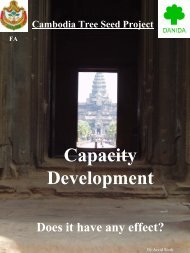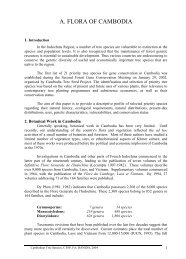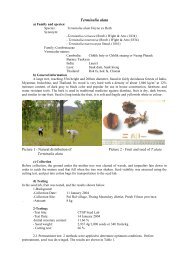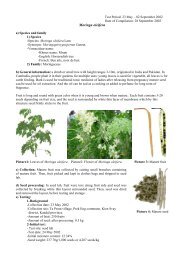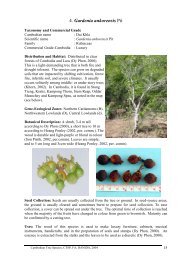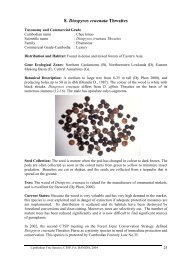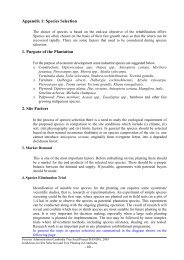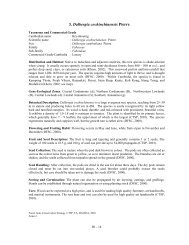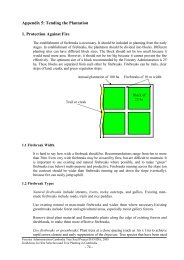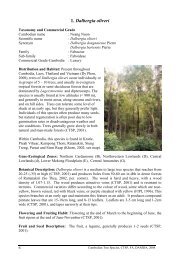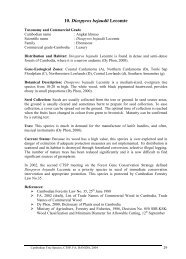Cambodia Forest Gene Conservation Case Study Part II
Cambodia Forest Gene Conservation Case Study Part II
Cambodia Forest Gene Conservation Case Study Part II
Create successful ePaper yourself
Turn your PDF publications into a flip-book with our unique Google optimized e-Paper software.
• Flowering and fruiting habit<br />
• Fruit and seed description<br />
• Seed handling<br />
• Sowing and germination<br />
• Current situation including conservation status based on local information<br />
• Uses<br />
• IUCN classification<br />
Based on this information, monographs for the 21 priority species and digitized distribution maps<br />
were prepared.<br />
Information on <strong>Cambodia</strong>n tree species is limited. Available documentation has<br />
been compiled into monographs for each of the 21 priority species.<br />
Figure 3. Distribution map for Dalbergia oliveri.<br />
4.3 Selection of <strong>Conservation</strong> Methods<br />
<strong>Conservation</strong> of forest genetic resources can be described as evolutionary or dynamic when the<br />
genetic composition of tree species changes over time, allowing for adaptation to changing<br />
environmental conditions. Static conservation, on the other hand, is used to maintain specific<br />
genetic compositions.<br />
In-situ conservation is conducted at the site of origin and is the principle method for the<br />
conservation of forest genetic resources, whereas ex-situ conservation takes place outside the native<br />
9
habitats of the populations. Ex-situ is a more expensive approach, sometimes necessary in the case<br />
of rapid forest loss and degradation. Ex-situ activities generally complement in-situ conservation.<br />
The working group decided, based on an analysis of pros and cons, that in-situ conservation should<br />
be the primary conservation method, supported by ex-situ conservation when needed.<br />
Within the natural forests of <strong>Cambodia</strong>, in-situ conservation is the preferred<br />
option, to be complemented, in some circumstances, by ex-situ conservation.<br />
4.4 Identification of the <strong>Conservation</strong> Stands<br />
The number of stands to be conserved and their geographical distribution are identified through a<br />
comparison of gene ecological zones with the species conservation status. The identification<br />
process may follow the principles below (DFSC, 1997).<br />
1. Overlay the gene ecological zones with:<br />
• Past and present geographical distribution of the species<br />
• Occurrence of the species in ongoing planting programmes and protected areas<br />
• Location of provenances/populations of proven value<br />
2. Consider factors affecting genetic variation, conservation status, and the<br />
conservation investment requirements:<br />
• Type of distribution area<br />
• Reproduction and dispersal biology<br />
• Differences between past and present distribution<br />
• Size and geographical location of past and ongoing planting programmes, and<br />
origin of the planting material used<br />
• Possible effects of selective logging/felling in each zone<br />
• Occurrence of populations in protected areas<br />
• Degree of threats<br />
• Land tenure and associated options and costs<br />
3. Decide on appropriate geographical distribution and number of areas per zone to be<br />
sampled for conservation of genetic resources of selected species.<br />
The number of populations selected for conservation in each zone should generally be higher for<br />
out breeding species with scattered distribution, insect pollination, and limited seed dispersal,<br />
assuming larger genetic variation between populations than for species with continuous distribution,<br />
wind pollination and wide seed dispersal. Factors to consider in stand selection include<br />
(FAO/IPGRI/DFSC, 2004):<br />
• Abundance of target species and presence of key associated species<br />
• Low level of risk/threats (including secure land tenure)<br />
• Committed and adequately staffed management agency<br />
• Support from local people, owners and users of the area<br />
• Compact shape of area and presence of forest buffer zone<br />
• Possible opportunities to conserve other priority species<br />
• A minimum of 2 stands in each gene ecological zone.<br />
10
CTSP began to establish gene conservation/seed stands early in 2004. The first stands were selected<br />
based on accessibility and level of knowledge available about the species. By the end of 2005, 35<br />
stands of 20 high value tree species from the natural forest had been established, at 16 different<br />
locations and within 6 of the 10 gene ecological zones (Table 2, page 14). The sizes of the stands<br />
vary from 4 to 117 hectares.<br />
Specific Costs for the Preparation of the <strong>Forest</strong> <strong>Gene</strong> <strong>Conservation</strong> Strategy<br />
US$<br />
• Manpower,FA 10 000<br />
• Adviser: process facilitation, technical co-ordination 15 000<br />
• Consultants 30 000<br />
• Utilities/data/seminars 10 000<br />
• Printing 5 000<br />
• CD-roms 3 000<br />
• Distribution 2 000<br />
Total Costs 75 000<br />
11
5. Establishment and Protection of the <strong>Conservation</strong> Stands<br />
<strong>Forest</strong> gene conservation stands are established at the locations illustrated in Figure 4 below,<br />
mapped according to their GPS points. They are referred to throughout this section by the name of<br />
the nearest village, with further key information presented in Table 2 on page 14.<br />
All except one of these stands are established in-situ within the processes described below. <strong>Forest</strong><br />
gene conservation at Kbal Chhay is ex-situ, and is addressed in Section 5.5.<br />
Figure 4. Location of <strong>Forest</strong> <strong>Gene</strong> <strong>Conservation</strong> Areas<br />
5.1 The <strong>Part</strong>icipatory Approach<br />
Local people are often those best placed to manage local resources, and participatory approaches to<br />
natural resource management have a potential to contribute both to poverty reduction towards<br />
sustainable livelihoods, and sustainable forest management. The <strong>Forest</strong> <strong>Gene</strong> <strong>Conservation</strong> Strategy<br />
identifies participatory approaches as essential for in-situ activities through the integration of<br />
conservation and local development efforts.<br />
<strong>Part</strong>icipatory approaches to forest gene conservation are being explored, in several locations, to<br />
assess their potential, and to secure access to resources contained therein, for respective local<br />
people. Local knowledge of forest resources is demonstrated during field visits to forest gene<br />
conservation areas with community representatives which, in Krang Chek, often result in the<br />
collection of various fruits, vegetables, and vines, with detailed explanations of their properties and<br />
uses as food or medicines.<br />
Such approaches are clearly not suitable in all cases. By their very nature, remaining stands of<br />
endangered tree species are located in remote areas of natural forests, and hence, far, and not easily<br />
accessible from communities. The distance between the community and the forest gene<br />
conservation area, however, is not necessarily a good indicator of their willingness to travel to the<br />
site for conservation purposes. For example, villagers are currently managing forest gene<br />
12
conservation areas at distances of 4 km (Kompeng), 8 km (Phum O), 5 km (Dei Krahom). Table 2,<br />
on page 14, indicates that others live in closer proximity to forest gene conservation areas (Phum<br />
Thmei 1 km, Patang 1 km, Trapieng Kroung 1.5 km) but are reluctant to participate in their<br />
management. Motivations for participation are further explored below.<br />
Motivation<br />
<strong>Part</strong>icipatory approaches to forest gene conservation can only be sustained if the participants<br />
themselves perceive clear benefits for their efforts. Experiences to date suggest that motivation for<br />
participation be linked to ownership, immediate economic benefit, and cultural/spiritual<br />
significance. Lack of incentive is often cited as the main reason for rural people not to involve<br />
themselves in forest gene conservation, and whilst sometimes linked to a perception of forest<br />
resource abundance, it is more often related to monetary incentive. This can be illustrated drawing<br />
on the experiences of project collaboration with the World Food Programme (WFP), which<br />
provided food support to community members in Sam Aong in return for their participation in the<br />
management of a forest gene conservation stand. Members were organised into groups of 5 people<br />
each which patrolled on a 10-day rotation basis. Following re-strategising within WFP, this area<br />
was not longer considered a priority, and the support lost. Whilst the community members still<br />
access the conservation area and surrounding forest to collect forest products for sale, they will also<br />
report any illicit activities to local foresters, but are no longer prepared to conduct regular patrols of<br />
the conservation area. The management of this area, within a former forest concession, has<br />
subsequently been re-allocated to the <strong>Forest</strong>ry Administration, with, on average, four monitoring<br />
trips each month.<br />
Wherever possible, forest gene conservation areas<br />
are established within broader community forest<br />
settings, and integrated into ongoing community<br />
development activities. Community forestry<br />
provides a mechanism for formal recognition of<br />
rural people as resource managers, offers<br />
contributions to sustainable livelihoods through<br />
increased income from the sale of forest products<br />
and improved food security, and allows for wider<br />
buffers of protection for the forest gene<br />
conservation stands. In Kompeng, the hill upon<br />
which the forest gene conservation stand is located<br />
is of great significance to the local population as a<br />
site of many historical battles, and therefore, a<br />
potential tourist area.<br />
Statue for protection of tree species in the<br />
forest gene conservation stands in Kompeng<br />
Strong relationships between stakeholders are fundamental in participatory approaches. Recent<br />
discussions with two groups of people living in close proximity to a forest gene conservation area<br />
illustrate this, as both groups fall under the jurisdiction of the same forestry officials. One group<br />
described their relationship as very good, as the forestry officials are supportive of its community<br />
forestry activities. The other group told a very different story, highlighting worsening relations, due<br />
the perception of them by local authorities as encroaching into the forest area.<br />
13
Table 2. <strong>Forest</strong> <strong>Gene</strong> <strong>Conservation</strong> Areas and Management Types<br />
<strong>Forest</strong> Number of Year of <strong>Gene</strong> Distance to Management Management<br />
GCA Species<br />
Area (ha) mother trees establishment ecological nearest village type agreement<br />
No.<br />
marked<br />
zone<br />
1 Dalbergia bariensis 12.5 78 2001 d 1km Phum Thmey FA Triage<br />
Prakas<br />
2 Sindora cochinchinensis 117 97 2000 d 5km Sam Aong FA Triage Prakas<br />
3 Tarrietia javanica 117 39<br />
4 Shorea hypochra 117 22<br />
5 Shorea guiso 117 19<br />
6 Dipterocarpus costatus 117 396<br />
7 Anisoptera glabra 117 323<br />
8 Pterocarpus macrocarpus 20 83 2002 d 8km Phum O <strong>Part</strong>icipatory Prakas and CFA<br />
9 Azadirachta indica 50 90 C In Wat Thmei village Private Verbal<br />
10 Pinus merkusii 104 72 2002 d 20km Dong Kda FA Triage None<br />
11 Fagraea fragrans 104 72<br />
12 Dalbergia bariensis 21 21 2002 1.5km Teun FA Triage Prakas<br />
13 Pterocarpus macrocarpus 21 20 G<br />
14 Xylia xylocarpa 21 22<br />
15 Afzelia xylocarpa 18 27 2002 G 1km Patang FA Triage Prakas<br />
16 Dalbergia bariensis 18 41<br />
17 Pterocarpus macrocarpus 18 14<br />
18 Afzelia xylocarpa 20 26 2002 G 1.5km Teun FA Triage Prakas<br />
19 Dalbergia bariensis 20 17<br />
20 Sindora cochinchinensis 20 7<br />
21 Hopea ferrea 30 88 2002 G 4km La Oeun FA Triage Prakas<br />
22 Dalbergia cochinchinensis 50 121 2002 D 6km Khnar Krao FA Triage None<br />
23 Dipterocarpus alatus 20 43 2001 D Angkor Park APSARA Verbal<br />
24 Pterocarpus macrocarpus 100 160 2004 d 1.5km Trapieng Kroung FA Triage None<br />
25 Xylia xylocarpa 100 141<br />
26 Sindora cochinchinensis 100 87<br />
27 Haldinia cordifolia 100 62<br />
28 Toona sureni 4 26<br />
8km Andoung<br />
2004 g<br />
Kraloeung FA Triage None<br />
29 Scaphium macropodum 10 78 2004 A 2hrs Krang Chek <strong>Part</strong>icipatory Towards CFA<br />
30 Sindora cochinchinensis 18.5 37 2005 A 5km Dei Krahom <strong>Part</strong>icipatory Towards CFA<br />
31 Dalbergia cochinchinensis 18.5 26 (Krang Chek)<br />
32 Dalbergia bariensis 18.5 37<br />
33 Pterocarpus macrocarpus 18.5 33<br />
34 Sindora cochinchinensis 96 45<br />
35 Dalbergia bariensis 96 69<br />
2005 C 4km Kompeng <strong>Part</strong>icipatory Towards CFA<br />
(Prakas: Ministerial Declaration, Triage: Lowest Level of <strong>Forest</strong>ry Administration)<br />
Valuation<br />
<strong>Forest</strong> gene conservation areas are managed to offer a diversity of forest products and services, but<br />
this is not sufficient to sustain participatory management. Full environmental valuations indicate the<br />
value of biodiversity to often outweigh financial values of timber and non-timber forest products,<br />
thereby validating forest conservation as the most economic management option. However, whilst<br />
there are no mechanisms in place to ensure that monetary benefits of managing and protecting these<br />
resources accrue to the farmer/tree manager, there remains little incentive for forest gene<br />
conservation in itself.<br />
Angkor Park was internationally recognised as a World Heritage Site in 1995, and is protected and<br />
managed by APSARA (authority for the protection and management of Angkor and the region of<br />
Siem Reap), which also provides mechanisms for national and international collaboration in<br />
activities under its jurisdiction. A small area within the park has been designated for the<br />
14
conservation of Dipterocarpus alatus, which is probably afforded the best protection of all forest<br />
gene conservation areas established to date. Its existence, within the wider setting of Angkor Park,<br />
is clearly valued highly in economic terms, illustrated by the ever increasing number of visitors<br />
willing to pay entrance fees, and consequently, the increasing annual revenue that can be used for<br />
ongoing and future conservation.<br />
Local people are often those best placed to manage local resources. However,<br />
participatory approaches to forest gene conservation can only be sustained if the<br />
participants themselves perceive clear benefits for their efforts.<br />
5.2 The Establishment Process<br />
Local levels of <strong>Forest</strong>ry Administration are asked to identify potential forest gene conservation<br />
areas based on criteria defined within the <strong>Forest</strong> <strong>Gene</strong> <strong>Conservation</strong> Strategy. Following this, the<br />
proposed sites are further assessed by members of the <strong>Cambodia</strong> Tree Seed Project, and discussions<br />
are begun with communities that are situated close by.<br />
An exception to this was the establishment of the forest gene conservation area in Krang Chek, in<br />
which project staff members were invited to visit a community forest with representatives of its<br />
management committee, supporting organisation (American Friends Service Committee), and local<br />
forestry officials. Here, the establishment of the forest gene conservation areas occurred<br />
simultaneously to the preparations towards a community forestry agreement. This meant that the<br />
conservation area was planned into the community forest from the outset, and provides a good<br />
example of establishment. It followed the process below:<br />
• Preliminary visit to assess and discuss the potential for forest gene conservation with<br />
community representatives and forestry officials<br />
• <strong>Part</strong>icipatory land use planning, as part of the community forestry development, identified<br />
and set aside special management areas for two forest gene conservation areas covering five<br />
species<br />
• Establishment of the forest gene conservation areas, with community representatives and<br />
forestry officials, using GPS to map the boundaries and red paint to physically demarcate<br />
the site. Within the site, lines were marked out, and each line assessed for good potential<br />
mother trees of the identified species, which were allocated a numbered metal tag, and<br />
recorded on a data collection sheet.<br />
• The forest gene conservation areas were registered, GPS data and tree information entered<br />
into the database within the project office, and copies returned to the community forestry<br />
committee.<br />
• The forest gene conservation areas were mapped and addressed within the community<br />
forestry management planning process.<br />
In the case that there are no communities within the immediate vicinity or no interest demonstrated<br />
in forest gene conservation, sites are established under the management of decentralised levels of<br />
<strong>Forest</strong>ry Administration.<br />
15
Mother tree marked and tagged<br />
Registration onto data collection sheets<br />
Current status<br />
Thirty-five forest gene conservation stands, amounting to a total area of 691 hectares, comprising<br />
20 endangered tree species (including 6 priority species) have been established to date. Five species<br />
are conserved in more than one gene ecological zone, whilst other priority species are not yet<br />
conserved anywhere. To date, and as illustrated in Table 2, on page 14, the majority of forest gene<br />
conservation areas fall within D/d zones, followed by G/g zones, representing those areas with the<br />
best remaining forest stands.<br />
5.3 Management of the <strong>Conservation</strong> Stands<br />
In consideration of the remoteness of many potential forest gene conservation stands, two options<br />
for their management are adopted within <strong>Cambodia</strong>, although both require the same level of<br />
detailed stand management plan.<br />
• <strong>Part</strong>icipatory approaches, described in detail above<br />
• Management by the <strong>Forest</strong>ry Administration, where participatory approaches are not<br />
feasible.<br />
Structure, Roles and Responsibilities<br />
Optimal conservation management draws on the strengths, whilst minimising the weaknesses of,<br />
the range of different stakeholders, which could include the <strong>Forest</strong>ry Administration (central and<br />
local levels), and other local authorities, communities, supporting organisations, the private sector,<br />
and APSARA, as outlined in Table 3.<br />
16
Table 3. Responsibilities of Different Stakeholders<br />
Stakeholder<br />
<strong>Forest</strong>ry<br />
Administration<br />
Community<br />
Supporting<br />
Organisations<br />
Commune Council<br />
Private sector<br />
APSARA<br />
Responsibilities<br />
Identification of potential forest gene conservation areas<br />
Technical support to establishment, management planning,<br />
implementation and monitoring<br />
Awareness raising<br />
Development of appropriate supportive legislation and regulations<br />
Direct management, where participatory methods are not feasible<br />
<strong>Forest</strong> gene conservation<br />
Evaluation and monitoring<br />
Mobilisation, organisation<br />
Technical expertise and assistance<br />
Training<br />
Integration of forest gene conservation into commune development<br />
planning<br />
Liaison with <strong>Forest</strong>ry Administration and supporting organisations<br />
for technical and financial support<br />
<strong>Conservation</strong> of species within agricultural landscapes<br />
<strong>Conservation</strong> of species within Angkor Park and the region of<br />
Siem Reap<br />
Current Management Approaches<br />
As indicted above, a number of approaches to forest gene conservation are being piloted, and are<br />
presented in Table 4 below. Each requires a slightly different type of agreement as illustrated.<br />
Table 4. Types of Management Agreements<br />
Type of<br />
management<br />
<strong>Part</strong>icipatory<br />
Private<br />
<strong>Forest</strong>ry<br />
Administration<br />
Protection<br />
Authority<br />
Type of area<br />
Within<br />
community area<br />
On agricultural<br />
land<br />
Within natural<br />
forest -<br />
remote from<br />
communities, or<br />
communities not<br />
interested<br />
Within World<br />
Heritage Site<br />
Management<br />
incentive<br />
Immediate economic<br />
benefit;<br />
Cultural significance<br />
Wide range of tree<br />
products<br />
<strong>Part</strong> of mandate<br />
<strong>Conservation</strong>;<br />
Cultural significance;<br />
Global significance;<br />
Tourism<br />
Management No. of FGC<br />
agreement Areas<br />
Community<br />
8<br />
<strong>Forest</strong>ry<br />
Agreements;<br />
Ministerial<br />
Declarations<br />
Verbal 1<br />
Ministerial<br />
Declarations<br />
None, APSARA<br />
has sole<br />
authority<br />
25<br />
1<br />
17
Stand Management Plans<br />
Each forest gene conservation area should have its own management plan, as outlined in the <strong>Forest</strong><br />
<strong>Gene</strong> <strong>Conservation</strong> Strategy, ideally as a component of a broader forest, protected area, or<br />
community forestry management plan, and at a minimum should contain:<br />
• Basic information, such as maps, boundaries, tenure status, managers, history,<br />
environmental characteristics<br />
• Reference information, including inventories, census and ecological/genetic studies<br />
• Description of roles, responsibilities and rights of all involved in the management and use<br />
of the forest gene conservation area and its resources<br />
• Work plans and budgets for management and monitoring<br />
• Assessment of potential risks and threats, and contingency plans to deal with these<br />
The project is working towards this, but currently only basic information is available.<br />
Threats<br />
Some forest gene conservation areas are under threat from encroachment (increasing population,<br />
agricultural conversion, military development, land speculation), and by illegal logging of the high<br />
value timber to be found there, neither of which can effectively be addressed by local populations.<br />
Areas under highest threat, therefore, are likely to be those with higher population density, or<br />
proximity to good roads. These areas include Trapieng Kroung, Knar Krao, and Sam Aong. Even<br />
where community management appears assured, fear is expressed that the community will be<br />
powerless to act against powerful elites (business, or individuals), a common risk in <strong>Cambodia</strong>.<br />
In general, forest gene conservation areas are considered to be fairly safe by their managers,<br />
although the surrounding forest is under higher pressure. At a local level, people in Sam Aong use<br />
the natural forest, but avoid the forest gene conservation areas as they are aware of their status.<br />
However, there was no consideration of conservation measures for the natural forest due to an<br />
abundance of resources.<br />
Land use decisions, especially in relation to agricultural concessions, taken externally to forest gene<br />
conservation activities could negatively affect those areas. However, to the extent possible,<br />
protection agreements have been reached for the forest gene conservation areas, but to varying<br />
levels. These are further outlined, with examples, in Section 5.4 below.<br />
5.4 Management Agreements<br />
As indicated in Table 4 on page 17, the type of management agreement differs according to the type<br />
of management. Whilst a number of agreements have been formalised, some are still in process, but<br />
are not necessary in all cases. Examples of agreements can be found in Appendix 3.<br />
Ministerial Declarations<br />
Signed by the Minister for Agriculture, <strong>Forest</strong>s and Fisheries, ministerial declarations provide<br />
recognition and protection status for forest gene conservation areas. They are of permanent validity<br />
that can be over-ridden only by new ministerial declarations affecting the same area that must refer<br />
to existing protection measures. They are at a higher level within the legislative hierarchy than<br />
community forestry agreements.<br />
18
Community <strong>Forest</strong>ry Agreements<br />
The Community <strong>Forest</strong>ry Sub-Decree determines rules for the establishment, management and use<br />
of community forests, and provides a mechanism for official recognition to communities as<br />
managers of the forest resources. Of relevance for forest gene conservation, its objectives include:<br />
• To establish procedures to enable communities to manage, use and benefit from forest<br />
resources, to preserve their culture, tradition and improve their livelihoods<br />
• To provide an effective means for a community forestry community to participate in the<br />
reforestation, rehabilitation and conservation of natural resources, forest and wildlife<br />
Community forestry agreements are written agreements between communities and the <strong>Forest</strong>ry<br />
Administration that grant and protect the community’s rights within any specific area to access, use<br />
manage, protect and benefit from forest resources in a sustainable manner. They are effective for 15<br />
years from the date of approval, but are renewable. Once such an agreement is reached, forest gene<br />
conservation areas can be specifically addressed within the Community <strong>Forest</strong>ry Management Plan.<br />
To date, no community forestry agreements have been officially approved within <strong>Cambodia</strong>.<br />
However, a number of community forests have been informally established, and are in the process<br />
of submitting applications, and preparing management plans. At Krang Chek and Dei Krahom, 5<br />
forest gene conservation stands are identified and mapped within the community forestry<br />
management plan, and the community is working with FA and CTSP to develop special<br />
management procedures.<br />
Mapping the forest gene conservation area<br />
Community forestry management planning<br />
Verbal agreements<br />
Written agreements are relevant only for areas within the jurisdiction of the <strong>Forest</strong>ry<br />
Administration. Within other areas, for example, in the privately owned agricultural plots within<br />
Wat Thmei village, verbal agreements were made with individual farmers, when their trees were<br />
registered. Discussions held during the establishment of the forest gene conservation area were<br />
documented as minutes.<br />
19
5.5 Ex-Situ <strong>Conservation</strong><br />
In-situ is the preferred option for forest gene conservation, where it is possible to ensure sufficiently<br />
high protection of the individual conservation areas/stands. When protection is not possible in the<br />
natural forest, ex-situ conservation can be considered. Ex-situ conservation is often combined with<br />
forest tree improvement work.<br />
Kbal Chhay Protected Watershed (see Figure 4 on page 12) was selected as an appropriate ex-situ<br />
cum tree improvement site due to its official conservation status (through Sub Decree). Three types<br />
of activities are ongoing:<br />
• Seed orchards for 7 species<br />
• Provenance trials for 4 species<br />
• Species elimination trials for 21 species<br />
The individual plots are regularly measured and the data recorded within a computerised database.<br />
Detailed analysis of the data will be done when sufficient data sets have been recorded.<br />
Provenance trials are also being conducted at the Royal University of Agriculture in Phnom Penh.<br />
More trial sites in other ecological sites will be identified in the near future.<br />
6. Capacity Building, Training and Awareness Raising<br />
<strong>Forest</strong> gene conservation involves numerous disciplines, including management, participatory<br />
approaches, genetic knowledge, analytical knowledge, GIS-tools, biological and silvicultural<br />
knowledge, analysis, planning and evaluation. In short, forest gene conservation, just like other<br />
areas of natural resource management, poses complex challenges. Naturally, such a crossdisciplinary<br />
activity highlights the gap in capacity at present compared to what is required to<br />
prepare a cost-efficient forest gene conservation programme.<br />
The <strong>Cambodia</strong> Tree Seed Project was faced with the fact that the capacity for forest gene<br />
conservation had to be built from the very beginning, not only technically, but also institutionally,<br />
managerially and financially.<br />
Capacity building has, therefore, been the central element of the <strong>Cambodia</strong> Tree Seed Project,<br />
taking the shape of training courses, long/short term studies, on the job training, coaching, feedback<br />
sessions, following up, etc.<br />
A range of approaches has been adopted and include classroom sessions, learning by doing,<br />
coaching, study tours/field visits, workshops and seminars, within various settings (national,<br />
regional, international) and therefore, using Khmer in some cases and English in others. Capacity<br />
building has always targeted specific and pre-assessed learning levels i.e. “skills”, “knowledge”<br />
and/or “attitude” and the approach has been much built on values, concepts and beliefs.<br />
Training activities undertaken may be divided into the following categories:<br />
A: specific technical training courses as, for example, forest gene conservation methodologies,<br />
seed procurement, tree improvement, reproduction biology, seed collection and treatment, tree<br />
20
climbing, gene conservation stand establishment, gene conservation stand management, ecological<br />
zonation, domestication of indigenous species, tree planting, nursery establishment, identification of<br />
priority species, forest gene resource conservation, seed testing, seed certification, rehabilitation of<br />
degraded stands, marketing of non timber forest products, training in provenance trials.<br />
B: courses of general character as, for example, use of GPS/GIS tools, word processing,<br />
spreadsheet and data base programmes, training needs assessment, use of internet, web page design,<br />
participatory land use planning, participatory rural appraisals, research experimental designs,<br />
accounting, extension training, economic valuation, monitoring and evaluation, English language.<br />
C: attitudinal, management, and policy formulation as, for example, critical thinking, general<br />
management, project management and evaluation, project formulation, HRD courses, extension,<br />
training of trainers, conflict resolution, management of tree seed programmes, policy support and<br />
development.<br />
Table 5 (below) presents the number of participants in different types of training courses and<br />
demonstrates the shift towards other target groups as capacity within counterpart and national level<br />
groups developed.<br />
Table 5. <strong>Part</strong>icipants in Training Events<br />
Year Workshops,<br />
<strong>Study</strong> tours,<br />
Specialist and<br />
general courses<br />
1999 International<br />
National<br />
2000 International<br />
National<br />
2001 International<br />
National<br />
2002 International<br />
National<br />
2003 International<br />
National<br />
2004 International<br />
National<br />
2005 International<br />
National<br />
Total International<br />
National<br />
No. of<br />
<strong>Part</strong>icipants<br />
2<br />
0<br />
9<br />
117<br />
18<br />
131<br />
26<br />
446<br />
32<br />
636<br />
17<br />
267<br />
32<br />
636<br />
113<br />
1853<br />
<strong>Forest</strong>ry<br />
Administration<br />
x<br />
x<br />
x<br />
x<br />
x<br />
x<br />
x<br />
x<br />
x<br />
x<br />
x<br />
x<br />
x<br />
x<br />
Target Groups<br />
National Provincial<br />
staff<br />
Other<br />
stakeholder<br />
s<br />
x<br />
x x<br />
x x<br />
x x<br />
x<br />
x x<br />
x<br />
x x x<br />
x x<br />
x x x<br />
x<br />
x x x<br />
x<br />
x<br />
x<br />
x<br />
x<br />
x<br />
21
The impact may be summarised as follows:<br />
⇒ core staff and 50-75 other selected field staff equipped with significant technical skills and<br />
knowledge, and in addition, some significant attitudinal changes in favour of participatory<br />
approaches and initiatives coupled with an ability to obtain further knowledge.<br />
⇒ a far reach for awareness of the importance and the value of indigenous tree species and the<br />
importance of conserving their populations before they become too eroded.<br />
⇒ a far reach for technical knowledge to all levels of the <strong>Forest</strong>ry Administration, community<br />
members, NGOs, the armed forces and the private sector.<br />
⇒ upgraded teaching skills and knowledge at the Royal University of Phnom Penh, Royal<br />
University of Agriculture and Preak Leap National School of Agriculture, for lectures ensuring<br />
that knowledge of forest gene conservation is obtained by all graduates.<br />
The massive training offered has enabled staff of the <strong>Forest</strong>ry Administration<br />
and other key stakeholders to progress within respective fields more openly and<br />
much more confidently.<br />
7. Institutionalisation of <strong>Forest</strong> <strong>Gene</strong> <strong>Conservation</strong> Activities<br />
CTSP will terminate at the end of June 2006, and to ensure sustainability and continuation of its<br />
activities in general, and the forest gene resource conservation activities in particular,<br />
institutionalisation at the central level of the <strong>Forest</strong>ry Administration, as well as field level, is<br />
needed.<br />
7.1 Central Level<br />
Most FA staff members working in CTSP, including the daily manager, are assigned from the<br />
<strong>Forest</strong> and Wildlife Science Research Institute (FWSRI) within FA, (see Figure 5 on page 23).<br />
When CTSP terminates these key staff members will return to this institute. From an<br />
institutionalisation and sustainability point of view this is important, and it is equally important that<br />
all the equipment from the small CTSP seed laboratory will follow the staff and the same goes for<br />
computers, library, registers, all published material, etc. The home page, www.treeseedfa.org,<br />
should be kept open and updated. These in themselves will not necessarily ensure sufficient<br />
financial means to continue CTSP activities at the present level, but will ensure that the very well<br />
developed knowledge base related to use and conservation of forest genetic resources is kept as a<br />
unit/group within FA. The group will be nested in the FWSRI.<br />
22
Figure 5. Organogramme of <strong>Forest</strong>ry Administration<br />
Source: FA, 2004<br />
23
To continue the forest gene conservation activities at a minimum level, the following are needed:<br />
i) maintainance of the stands already established, through maintenance of established<br />
management agreements;<br />
ii) establishment of additional stands so that a minimum of 2 stands of each of the 21 priority<br />
species exist in the two gene ecological zones holding the major part of the natural distribution<br />
area for the species in question.<br />
This set-up requires up to a total of 84 conservation stands. A minimum conservation programme<br />
can not establish the required number of stands. Establishment of three stands per year is regarded<br />
as the minimum for an active conservation programme.<br />
Annual Costs for Continuing a Minimum <strong>Forest</strong> <strong>Gene</strong> <strong>Conservation</strong> Programme<br />
US$<br />
• Maintenance of existing conservation stands (35) 2 000<br />
• Establishment of additional stands (15), 3 per year 10 000<br />
• Administration 3 000<br />
• Information/extension service 3 000<br />
• Publications 3 000<br />
Total Costs 21 000<br />
The total government budget for FA (central and de-centralised parts) for 2005 amounts to US$2.3<br />
million. Considering its size, it is not possible to suggest an institutional setting within FA which<br />
will ensure the financial means needed to continue forest gene resource conservation activities at an<br />
appropriate minimum level.<br />
In order to ensure best possible sustainability and continuation of the present<br />
CTSP activities within FA, the CTSP staff assigned from the <strong>Forest</strong> and Wildlife<br />
Science Research Institute (FWSRI) shall return to this institute when CTSP<br />
terminates mid 2006. Other staff should follow to maintain a coherent active<br />
resource base. All seed lab. equipment, computers, registers, library, published<br />
material, etc., shall follow the former CTSP staff to FWSRI. It is also<br />
important to keep the CTSP home page (www.treeseedfa.org) active after mid 2006.<br />
7.2 Field Level<br />
Following the Independent <strong>Forest</strong>ry Sector Review of 2004, and in line with the <strong>Forest</strong> Law (2002)<br />
and the Declaration on the Organisation and Functioning of <strong>Forest</strong>ry Administration (2004), the<br />
<strong>Forest</strong> Management Office is preparing <strong>Forest</strong> Management Plans (FMP) at division level. This<br />
process includes the preparation of a guideline for use by the division offices.<br />
The FMPs will include management guidelines for all land under jurisdiction of FA (approximately<br />
40% of the total land area of <strong>Cambodia</strong>, and 67% of the forest area).<br />
24
Almost all the forest gene conservation areas established by CTSP are in land areas controlled by<br />
FA. A possible way to ensure continued management and protection of these areas and make room<br />
for establishment of additional areas, is to ensure forest gene conservation activities and seed source<br />
establishment are sufficiently covered by the guidelines for preparation of FMPs. CTSP has<br />
provided inputs to the preparation of these guidelines so that future FMPs will include descriptions<br />
of forest gene conservation/seed source activities as part of common forest management practices<br />
for all areas under control of FA.<br />
This model for institutionalisation of forest gene conservation activities at local levels within the FA<br />
structure will not necessarily ensure that sufficient financial means will be available to continue the<br />
activities at the present level. However, it will ensure that conservation activities become part of<br />
common forestry management practice in the forest areas under FA control.<br />
In order to ensure continued management and protection of the established<br />
forest gene conservation areas/seed sources, and to make room for<br />
establishment of additional areas, <strong>Forest</strong>ry Administration will ensure that major<br />
aspects of forest gene conservation are included in the guidelines for preparation<br />
of forest management plans at division level.<br />
8. Discussion and Future Prospects<br />
RGC has done an outstanding job regarding conservation of forest gene resources for future use.<br />
The conservation programme was prepared according to high systematic and technical standards.<br />
However, it is not yet completed as there are still a number of species to be conserved and a good<br />
number of conservation stands to be established in-situ as well as ex-situ.<br />
The <strong>Forest</strong>ry Administration in <strong>Cambodia</strong> is fully aware of the importance of continuing the<br />
conservation programme, which in the future will be maintained and expanded to include more of<br />
the highly endangered tree species from the natural forests. The <strong>Forest</strong> and Wildlife Science<br />
Research Institute under the <strong>Forest</strong>ry Administration will be responsible for the conservation<br />
programme. It is recognised and appreciated that the RGC will not be in a position to provide the<br />
full financial input needed to develop and to obtain the full benefits from the conservation<br />
programme.<br />
If the conservation programme should be continued and maintained in an optimal<br />
way, it is important that the donor community realises and accepts their<br />
responsibility and supports the programme not only verbally, but also financially.<br />
The support needed is little, but the future benefits will be tremendously large.<br />
25
References<br />
Burgess, S., A. Sloth and T. So. 2004, Costs, Benefits, and Enabling Conditions Related to Village<br />
Seed Supply Systems, <strong>Forest</strong>ry Administration/<strong>Cambodia</strong> Tree Seed Project/DANIDA<br />
<strong>Cambodia</strong> Tree Seed Project, 2006, Training Register<br />
Cheang, D., S. Burgess, A. Sloth, T. So and S. Sok. 2004, <strong>Cambodia</strong> Tree Species Monographs,<br />
<strong>Forest</strong>ry Administration/<strong>Cambodia</strong> Tree Seed Project/DANIDA<br />
Danida <strong>Forest</strong> Seed Centre. 1997, Planning National Programmes for <strong>Conservation</strong> of <strong>Forest</strong><br />
<strong>Gene</strong>tic Resources, Tech. Note No. 48<br />
So, T., A. Sloth, I. Duemmer, S. Burgess and S. Sok. 2003, <strong>Gene</strong> Ecological Zonation of <strong>Cambodia</strong>,<br />
<strong>Forest</strong> Administration/<strong>Cambodia</strong> Tree Seed Project/DANIDA<br />
FAO, 2005, Global <strong>Forest</strong> Resources<br />
FAO/IPGRI/DFSC, 2005, <strong>Forest</strong> <strong>Gene</strong>tic Resources <strong>Conservation</strong> and Management<br />
Royal Government of <strong>Cambodia</strong> (RGC), 1999, Sub-Decree on <strong>Forest</strong> Concession Management<br />
RGC. 2001, Second Five Year Plan for the <strong>Forest</strong>ry Sector 2001 – 2005<br />
RGC. 2002, Statement of the Royal Government on National <strong>Forest</strong> Sector Policy<br />
RGC. 2002, National Bio Diversity Strategy and Action Plan<br />
RGC. 003, The <strong>Forest</strong>ry Law<br />
RGC. 2003, Sub-Decree on Community <strong>Forest</strong>ry Management<br />
Sloth, A., 2005, Capacity Development, presented to the Annual Meeting of the <strong>Forest</strong>ry<br />
Administration in <strong>Cambodia</strong><br />
Sloth, A. and T. So. 2002, Seed Source Registration System, FA/CTSP/DANIDA<br />
So. T, A. Sloth, S. Burgess and I. Theilade. 2003, <strong>Forest</strong> <strong>Gene</strong> <strong>Conservation</strong> Strategy,<br />
FA/CTSP/DANIDA<br />
Traeholt. C., S. Lim, A. Sloth and S. Burgess. 2005, Capacity Needs Assessment of the Natural<br />
Resource Sector, FA/CTSP/DANIDA<br />
www.treeseedfa.org 2005, web site for <strong>Cambodia</strong> Tree Seed Project<br />
26
Annex 1<br />
Example of <strong>Forest</strong> <strong>Gene</strong> <strong>Conservation</strong> Area Registration Sheets<br />
(A) SEED SOURCE INFORMATION SHEET<br />
<strong>Cambodia</strong> Tree Seed Project<br />
a) Species Information Date of assessment: 31/03/05<br />
Seed source reference no. (one letter and three digits): ....................................................................<br />
<strong>Gene</strong> Ecological zone: C<br />
Provenance name: ............................................................Origin: .....................................................<br />
Species (botanical):Dal bariensis Common name: Neang Noun Species code:<br />
Seed source for other species (indicate seed source no.)<br />
b) Location description<br />
Seed source location:<br />
Province Pursath District: Phnom Kror Van Commune: Prorgnil<br />
Village: Kompeng<br />
Name of Map and sheet no: 5733 U.T.M…………………………………………………………..<br />
UTM coordinates :Starting point :03 74 329, 13 70 194.Ending point: 03 74 163,13 69 804<br />
Geographical coordinates: Latitude:....................................N, Longitude:.....................................E,<br />
Altitude:.........................................m.a.s.l<br />
c) Seed source classification<br />
Unclassified, Identified stand, Selected stand, Seed production area, Provenance seed stand, Seed<br />
orchard, indicate type, ESSO, SSO, CSO<br />
d) Type and ownership<br />
Type of seed source:<br />
<strong>Forest</strong> concession, Protected forest/forest reserve, Species mgt. areas,<br />
Private forest, Community forest, National park or wildlife reserve<br />
Seed source owner: Government, Private, and Other:..........................................................<br />
Name and address of owner/administration: Mr Seng Visal, chief of FATriage in Division Learch and Mr Roth<br />
Chang, chief of Prorgnil <strong>Forest</strong> Community<br />
Collection permit: Not required, required, indicate authority:.................................................<br />
Collection contacts:.............................................................................................................................<br />
27
e) Climatic records or estimates (optional)<br />
Nearest weather station: Pursath, Latitude: 12 0 33’ N, Longitude: 103 0 51’ E<br />
Altitude:............m.a.s.l, Distance from site(Km):...............................................................................<br />
Rainfall regime: Raining season (which month):.........................................................................<br />
Month Jan Feb Mar Apr May June July Aug Sept Oct Nov Dec<br />
Rainfall, mm 4,8 0,0 217,6 20,5 143,4 116,9 77,2 256,0 212,5 173,6 14,4 22,0<br />
Temperature<br />
22,5/<br />
34,3<br />
21,9/<br />
36,6<br />
24,1/<br />
36,9<br />
25,9/<br />
38,3<br />
25,4/<br />
38,3<br />
25,3/<br />
35,8<br />
24,7/<br />
39,5<br />
25,0/<br />
36,5<br />
24,6/<br />
34,3<br />
24,5/<br />
33<br />
21,9/<br />
32,1<br />
21,6/<br />
32,6<br />
Mean annual rainfall (mm): 104,9 Mean annual temperature, 0 C: 29,8<br />
Length of dry season (
i) Seed production<br />
Flowering period (start): May- June, Peak:.......................................................<br />
Fruit ripening period (start): July-October, Fruit peaking period (collection): November-January<br />
Harvestable fruit production (estimated):........................................................Kg/ha<br />
j) Accessibility<br />
Name and distance nearest provincial forest office: Prorgnil Triag of forest Administration<br />
Accessibility road, 2WD, 4WD, Remarks: Mostly all kinds of transportation means.<br />
Walking distance from nearest road accessible by 4WD, Km: Around 1 km<br />
Other information. Seed Source Area located in the Kampoulbey mountain of Prorgneal forest community, Pursath<br />
Province.<br />
k) Labor availability<br />
Name(s)of neares tvillage: Kompeng forest community<br />
Distance from seed source to nearest village: 5km<br />
Available laborers: People, living in the Kompeng Village, Purtsath Province.<br />
l) Other information (management recommendations, observation etc,)<br />
29
(C) MAP OF SEED SOURCE (typographical or sketch map)<br />
B.B<br />
Pursath<br />
03 83 469, 13 85 225<br />
P.P<br />
N<br />
S<br />
13, 6 km<br />
Mountain foot<br />
UTM:<br />
03 73 875<br />
13 70 259<br />
Kompoul Bey<br />
Mountain<br />
03 71 552<br />
13 71 619<br />
3, 5 km<br />
Seed<br />
Source<br />
96 ha<br />
Leach,<br />
Kror Van district<br />
30
Annex 2<br />
Example of Ministerial Declaration<br />
Department of <strong>Forest</strong>ry and Wildlife<br />
<strong>Cambodia</strong> Tree Seed Project<br />
# 40 Norodom Blvd, Phnom Penh, <strong>Cambodia</strong><br />
Tel.: (855) 23 215034;Email: ctsp@online.com.kh<br />
Guideline for development of<br />
a declaration<br />
1. The need of declaration<br />
Declaration is a jurisdiction tool to secure seed sources in forests under the control of the Ministry<br />
of Agriculture, <strong>Forest</strong>ry and Fisheries (MAFF). The declaration is normally issued by MAFF.<br />
If a seed source established inside a national park or any other protected areas, which is under the<br />
authority of the Ministry of Environment, a co-declaration between the two ministries is needed.<br />
2. Formulation process<br />
The Department of <strong>Forest</strong>ry and Wildlife (the <strong>Cambodia</strong> Tree Seed Project) is responsible for the<br />
formulation and processing of the declaration. The steps in formulating a declaration can be<br />
summarized as the following:<br />
o Review of existing declarations to get ideas.<br />
o Review of forestry law and other relevant regulations.<br />
o The making of declaration (see an example in the Annex 1). The main part of a<br />
declaration is the responsibilities of concerned parties. The writer has to be clear about<br />
who do what under their authorities. It is simpler if a seed source is inside an authority of<br />
MAFF compared to the one under the control of MOE. However, one must think that is<br />
it worth to make a declaration for an area, which is already secured by Royal Decree?<br />
It is also important to note that the declaration is always attached with a map(s) of the<br />
proposed area drawn by GIS group. The map can be topographical or/and administrative<br />
with a scale ranging from 1: 10 000 to 1: 100 000 according to the size of the seed<br />
source. However, to make it simpler the maps should suit the A4 size paper in landscape<br />
or portrait. A sketch map is not acceptable.<br />
31
o Number of declaration: the declarations developed by province, as an example: if there<br />
are three new seed sources that have been established in Mondul Kiri, they must be put<br />
in one declaration.<br />
It is wise to develop and process a group of declarations at one time rather than develop<br />
and process one by one. In this case one group of declarations was processed in one<br />
year.<br />
o Subsequent to finish the first draft the declaration must be submitted to the Vice Head of<br />
DFW (who is in charge of CTSP), together with formal letter asking to organise a<br />
meeting.<br />
o A meeting: to get suggestions/recommendations for correction, before sending to<br />
MAFF, the proposed declarations are put for discussion among the heads and vice heads<br />
of the offices under DFW for giving recommendations for correction.<br />
Other relevant stakeholders, such as a representative from forest office of the host<br />
province or a representative of the forest concession where the seed source is located,<br />
should be considered for invitation. The minimum number of participants should be 10<br />
and the maximum around 30. To avoid wasting time the meeting should be run in one<br />
morning or the maximum in one day.<br />
o Revision of the declarations: After the meeting the declarations must be immediately<br />
revised according to the decision of the meeting.<br />
o Resubmission: the final drafts of the declarations submitted again to the Head of DFW<br />
and request for submitting to MAFF.<br />
3. Processing the proposed declaration to MAFF<br />
The submission of the proposed declarations to MAFF is attached with a formal letter, to the<br />
minister, from the head of DFW (see an example in Annex 2). The proposed declaration is<br />
submitted to the administration office of MAFF. From there it will be processed until the minister.<br />
There can be a call for a meeting to defence the proposed declaration if it is necessary.<br />
4. Who can make and process a declaration?<br />
Any body who has background and has working experiences in forestry at least three years.<br />
However, in this case any counterpart of CTSP can do this work.<br />
5. Distribution of declaration<br />
After the declaration been approved and signed by the minister of MAFF it must be copied and sent<br />
to the recipient institutions as cc in the declaration itself for notification or taking action.<br />
32
Ministry of Agriculture,<br />
<strong>Forest</strong>ry and Fisheries<br />
No: ..... FA. MAFF<br />
Kingdom of <strong>Cambodia</strong><br />
Nation Religion King<br />
DECLARATION<br />
on<br />
Seed Source Establishment of Pinus mercusii and Fagraea fragrance<br />
in Kampong Thom Province<br />
MINISTER OF THE MINISTRY OF AGRICULTURE, FORESTRY AND FISHERIES<br />
• Seen the constitution of the Kingdom of <strong>Cambodia</strong>,<br />
• Seen Royal Decree No.NS/RKT/1198/72 dated 30 November, 1998 on the formation of the<br />
Royal Government of <strong>Cambodia</strong>;<br />
• Seen Royal Krom No.NS/RKM/0196/13 dated 24 January 1996 on the declaration to use<br />
the law on Establishment of the Ministry of Agriculture, <strong>Forest</strong>ry and Fisheries;<br />
• Seen Royal Krom No.NS/RKM/0802/016 dated 31 August, 2002 on the declaration to use<br />
the <strong>Forest</strong>ry Law;<br />
• Seen The Sub-decree No. 17 BK dated 07 April 2000 on the Organisation and<br />
Functioning Structure of the Ministry of Agriculture, <strong>Forest</strong>ry and Fisheries;<br />
• Pursuant to the request of the Head of the <strong>Forest</strong> Administration.<br />
IT IS HEREBY DECIDED<br />
Article 1: Establish a seed source area of Pinus mercusii and Fagraea fragrance with an area of<br />
104 hectares located in Kampong Thmar <strong>Forest</strong> Administration of Kra Year Commune, Santuk<br />
District, Kampong Thom Province. The boundaries of the seed source are defined in an annexed<br />
topographical map with a scale of 1:50 000 and the UTM co-ordinates of A (05 31 601; 14 09 923),<br />
B (05 31 325; 14 10 745), C (05 31 043; 14 10 721), D (05 30 283; 14 10 363), E (05 30 275; 14 09<br />
986), F (05 30 382; 14 09 750), G (05 31 368; 14 09 755) in a closed polygon. The objectives of<br />
establishing the seed source are conservation and study the genetic resources and collection of seeds<br />
for reforestation programs.<br />
Article 2: The establishment and management of the seed source are under the authority of the<br />
<strong>Forest</strong> Administrations with the following responsibilities assigned to:<br />
o The Central <strong>Forest</strong> Administration has the duty to co-ordinate, research study, extension<br />
and provide technical training in management techniques, maintenance and collection of<br />
seeds of Pinus mercusii and Fagraea fragrance in this area.<br />
o The District <strong>Forest</strong> Administration of Kampong Thom (Kampong Thmar Division) has<br />
the duties to manage, to maintain and to collect seeds including the prevention of forest<br />
fire and the cracking down effectively all illegal activities in the seed source.<br />
Article 3: <strong>Gene</strong>ral secretaries, Director of the Department of Administration, Director of the<br />
Department of Personnel and Human Resource Development, Director of the Department of<br />
Planning-Statistic and International Cupertino, Director of the Department of Accounting and<br />
Finance and Director of <strong>Forest</strong> Administration shall be responsible for the implementation of this<br />
declaration.<br />
33
Article 4: Any regulations with a meaning contradictory to this declaration considered invalid.<br />
Article 5: This declaration shall become judicial with effect from the date of the signature.<br />
Phnom Penh, Date:......................<br />
Minister<br />
CC:<br />
- The Council of Ministers<br />
- Ministry of Economy and Finance<br />
- Ministry of Environment<br />
- Ministry of Land Management and Construction<br />
- Kampong Thom Municipality<br />
"to be informed"<br />
- All institutions under the Ministry of Agriculture,<br />
<strong>Forest</strong>ry and Fisheries<br />
"for information"<br />
- As stated in article 3 "for taking action"<br />
- Document- File<br />
34
Annex 3<br />
Example of a Verbal Agreement<br />
Kingdom of <strong>Cambodia</strong><br />
Nation Religion King<br />
Minute<br />
On<br />
Seed Source Establishment of Azadirachta indica<br />
On January, 6, 2002, officials of the <strong>Forest</strong>ry Administration (<strong>Cambodia</strong> Tree Seed Project) cooperated<br />
with Bonteay Meanchey <strong>Forest</strong>ry Administration, Phnom Touch Commune Council and<br />
the Chief of Wat Thmey Village to establish a Seed Source of Azadirachta indica (Khmer Name:<br />
Sdaov) in Wat Thmey Village, Phnom Touch Commune, Mongkul Borey District, Bonteay<br />
Meanchey Province.<br />
<strong>Part</strong>icipation:<br />
1. Mr. So Thea Deputy of the <strong>Forest</strong>ry and Wildlife Science Research Institute,<br />
(CTSP Manager).<br />
2. Mr. Moy Rotha Official of The <strong>Forest</strong>ry Administration (CTSP official).<br />
3. Mr. Leung Sarath Official of Bonteay Meanchey <strong>Forest</strong>ry Administration.<br />
4. Mr. Eng Gnuon Seng Commune Council of Phnom Touch.<br />
5. Mr. Mol Sonn Chief of Wat Thmeay Village.<br />
A. Objective: The objective of the Seed Source is to conserve genetic resources of Azadirachta sp.<br />
in the area, and to supply seed for planting programmes in other areas of the country.<br />
B. Area: A 50 hectare square is demarcated. The trees, by nature, are scattered.<br />
C. Marking technique: Within clumps of trees (at least two), one was selected, and its diameter<br />
and height (DBH) recorded. Each selected tree is identified with a numberplate and ringed with red<br />
paint. The Seed Source consists of 90 trees belonging to 23 families in the commune.<br />
D. Signboard: A signboard was erected on a path to the seed source. The task of seed source<br />
establishment was completed on the same date as above.<br />
35



